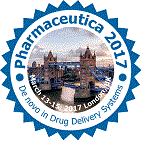
Marco Contardi
Italian Institute of Technology, Italy
Title: Transparent ciprofloxacin-polyvinylpyrrolidone antibiotic films and nanofiber mats as potential skin and wound care dressings
Biography
Biography: Marco Contardi
Abstract
Wound dressings have been evolving steadily in close conjunction with recent trends and advances in bio-based polymer processing. Dressings grew from materials or tapes that simply covered and concealed the wound, to materials that can interact with wounds so that important wound healing factors such as moisture management, active ingredient delivery and interaction with cells or proteins can be tuned or enhanced in situ. For chronic non-healing wounds or burns, for instance, one of the most important aspects is to prevent infection. As such, dressings should provide a continuous or quick release of the antiseptic agent at the wound surface to provide a long-lasting antimicrobial action in combination with maintenance of physiologically moist environment for healing. Most commercially available wound dressings are frequently opaque. Visual observation of the healing process is therefore prevented. Infection or other complications cannot be detected with opaque coverings. During inspection, dressing removal causes discomfort but also healing disruption, bleeding and granuloma formation. Transparent wound dressings are therefore highly desirable. Particularly, antiseptic loaded and adhesive free transparent wound dressings that can be easily absorbed by the wound are highly desirable. Hence, we demonstrate a facile water-based solvent casting process to incorporate a common insoluble antibiotic known as ciprofloxacin (Cipro) in its unmodified form in polyvinylpyrrolidone polymer using aqueous acetic acid solutions. Acetic acid enabled transparency, enhancement in antiseptic effect and softer films. Preliminary in vivo tests on C57BL/6J mice displayed good capacity to absorb exudate and dissolution rate of transparent antibiotic films on a model wound.

